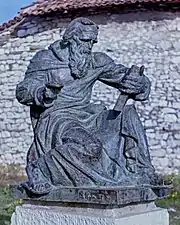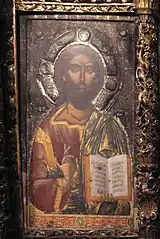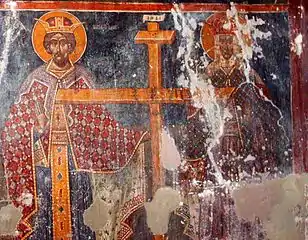
Onufri (Albanian: Onufri; Greek: Ονούφριος; Italian: Onufri), Onouphrios of Neokastro or Onouphrios Argytes, was a 16th century Archpriest of Elbasan and the most important painter of Orthodox murals and icons in the early post-Byzantine era in Albania.[1][2][3][4][5] He founded a school of painting in Berat and extended his influence as far afield as Kastoria (present-day Macedonia, Greece).[1][2][3][6] Trained in Venice, he infused Albanian icon painting with the artistic climate of the Italian Renaissance.[7] His works reveal a great degree of originality and ecclesiastically combined post-Byzantine and Gothic elements.[3][2] Onufri's works played a decisive role in the following trends of Albanian art, up to the 19th century.[1]
The Onufri Iconographic Museum, an Albanian national museum in Berat, is named after the painter.
Life
Little is known with certainty about Onufri's life and his existence only emerged in the early 20th century. Regarding his birthplace only an inscription in the Holy Apostles church, near Kastoria has survived. Onufri is believed to have been born in the early 16th century either in the region of Berat (in today's Albania) or near Kastoria or Grevena (in today's northern Greece).[8] The epithet Argitis, which appears in a fresco near Kastoria may point to Argos as his place of birth, although as he used it only once it is regarded probable that it refers to a location in the area of Kastoria.[8][9][10][11] His flawless Greek calligraphic inscriptions is an indicator that he received high-level education.[12] He was educated in the Republic of Venice and was a member of the Greek Brotherhood of Venice.[9]
In the climate of the time, the painting of Christian icons can be seen as an act to restore pre-Ottoman culture.[13] He was active in Berat and possibly Venice until 1547. Then he worked in both Berat and Kastoria and in 1555, in Shelcan near Elbasan. He may have also been the painter of various murals in the church of St. Nicholas near Prilep (North Macedonia).[14] After 1554, he lived and painted in the village of Valsh. In a number of churches his works were signed with the title "Protopapas" (Greek: Πρωτόπαππας), demonstrating a senior position in the church hierarchy.[12] However, his signature has not been preserved on icons that have been also attributed to him such as a Dodekaorton icon at that is preserved at the National Museum of Medieval Art in Korce. [12]
Work
Onufri introduced greater realism and individuality into facial expressions, breaking with the strict conventions of the time. He was the first to introduce the colour pink into icon painting. The secret of this colour was not passed on and died with him. His work is noted for the intense use of colours and the use of natural dyes.[15] According to Lucia Nadin, Onufri's painting well attests red as a traditional Albanian color.[4] According to Georgios Golobias the works of Onufri were significantly influenced by western art, as a result of his possible stay in Venice, being a member of the local Greek fraternity. On the other hand, Manolis Chatzidakis claims that western traces are few and they can be explained due to the contact with the paintings of the Cretan School.[16]
Onufri founded a school of painting in Berat, which was passed on to his son Nikolla, and upon his death to Onouphrios Cypriotes (Onufri Cypriota) and Kostandin Shpataraku.
Gallery
 "The Resurrection of Lazarus." Byzantine icon painted by Onufri (Onouphrios), 16th century. Museum of Mediaeval Art in Korça.
"The Resurrection of Lazarus." Byzantine icon painted by Onufri (Onouphrios), 16th century. Museum of Mediaeval Art in Korça. Fresco in Holy Apostles church in Kastoria (16th)
Fresco in Holy Apostles church in Kastoria (16th) Sts Peter and Paul fresco, Holy Apostles church in Kastoria
Sts Peter and Paul fresco, Holy Apostles church in Kastoria Mary and Child. Icon by Onufri (Onuphrios), 16th century.
Mary and Child. Icon by Onufri (Onuphrios), 16th century. Icon by Onufri in Cathedral of Berat.
Icon by Onufri in Cathedral of Berat..jpg.webp) Icon of the Apostle Saint Peter, painted by Nikolla, son of Onufri, second half of 16th century. Today Onufri-Museum Berat.
Icon of the Apostle Saint Peter, painted by Nikolla, son of Onufri, second half of 16th century. Today Onufri-Museum Berat. The Roman Emperor Constantine I with his mother Helena of Constantinople, who found the holy cross in Jerusalem. Icon painted by Nikolla, son of Onufri, in the St. Mary of Blachernae Church, Berat (Albania), second half of 16th century.
The Roman Emperor Constantine I with his mother Helena of Constantinople, who found the holy cross in Jerusalem. Icon painted by Nikolla, son of Onufri, in the St. Mary of Blachernae Church, Berat (Albania), second half of 16th century.
External links
References
- 1 2 3 Popa, Theophan (1974). "Onufri, master of fantasy and realism: a 16th-century Albanian painter of icons and frescoes virtually unknown outside his country". The UNESCO Courier. UNESCO. 27: 13–17.
- 1 2 3 Robert Elsie (2010). Historical Dictionary of Albania. Rowman & Littlefield. pp. 339–. ISBN 978-0-8108-6188-6.
- 1 2 3 Sakellariou, M. V., ed. (1997). Epirus, 4000 Years of Greek History and Civilization. Athens: Ekdotikē Athēnōn. p. 336. ISBN 960-213-371-6.
- 1 2 Nadin, Lucia (2008). Migrazioni e integrazione: il caso degli Albanesi a Venezia (1479-1552). Bulzoni. p. 83. ISBN 978-8878703407.
- ↑ Norris, H.T. (1993). Islam in the Balkans Religion and Society Between Europe and the Arab World. University of South Carolina Press. p. 68. ISBN 978-0-87249-977-5.
- ↑ Revue des études byzantines. Vol. 63–65. Institut français d'études byzantines. 2005. pp. 21–24.
- ↑ Williams, Bruce (2016). "The Eagle Rocks: Isolation and Cosmopolitanism in Albania's Pop-Rock Scene". In Ewa Mazierska (ed.). Popular Music in Eastern Europe: Breaking the Cold War Paradigm. Springer. p. 92. ISBN 9781137592736.
- 1 2 Sissiou, Ioannis. "Ο παλαιός των ημερών ως ξεχωριστή εικονογραφική σύλληψη του ζωγράφου Ονούφριου στην Καστοριά" (PDF). Recueil des travaux de l’Institut d’etudes byzantines. Retrieved 1 December 2011.
- 1 2 Rasolkoska-Nikolovska, Zagorka (2003), "Tvoreštvoto na slikarot Onufrij Argitis vo Makedonija ['The Painting Activity of Onufri Argitis in Macedonia']" (PDF), Zbornik Matice srpske za likovne umetnosti (in Macedonian), vol. 34–35, Matica Srpska, pp. 143–145,
spored G. Golobijas, slikarot se vikal Onufrios Argitis...Argitis, znači proishodot na Onufrije od Argos ili e prezime na zografot, izvedeno, najverojatno, spored mestoto na proishod na negovite predci...So točnoto čitanje na zborovite „Onufrios Argitis" i „Venecija" od ktitorskiot natpis vo Kostur i pronaođanjeto na arhivskite podatoci za Onufrij vo registrite na matično na grčkoto bratstvo vo Venecija, spored G. Golobijas davaat definitiven odgovor na dolgogodišnite polemiki okolu prašanjeto za nacionalnosta na Onufrij i negovoto studiranje vo Venecija. So ovie novi rezultati na G. Golobijas se složuva i G. Subotić, eden od najdobrite poznavači na postvizantijskoto slikarstvo na Balkanot. Sledejći go slikarstvoto na Onufrij, G. Subotić napolno se soglasuva vo pogled na nacionalnosta na slikarot, koj e Grk od Argos. [According to G. Golobijas, painter's name was Onufri Argitis... meaning that Argitis is derived from Onufri from Argos or the last name of the painter is most probably derived from the place of origin of his ancestors... G. Golobijas believes that correct reading of the text "Onufrios Argitis" and "Venice" in the donators inscription in Kastoria and discovery of archived data of Onufri in the registers of his parent Greek brotherhood in Venice, provide definitive answer to all long-lasting debates about the ethnicity of Onufri and his education in Venice. G. Subotić, one of the best Balkan's experts in the late-Byzantine painting agrees with this new conclusions of G. Golobijas. G. Subotić fully agrees about ethnicity of the painter Onufry who is Greek from Argos.]
- ↑ Rasolkoska-Nikolovska, Zagorka (2003), "Tvoreštvoto na slikarot Onufrij Argitis vo Makedonija ['The Painting Activity of Onufri Argitis in Macedonia']", Zbornik Matice srpske za likovne umetnosti (PDF), vol. 34–35, Matica Srpska, pp. 143–145,
spored G. Golobijas, slikarot se vikal Onufrios Argitis...Argitis, znači proishodot na Onufrije od Argos ili e prezime na zografot, izvedeno, najverojatno, spored mestoto na proishod na negovite predci...So točnoto čitanje na zborovite „Onufrios Argitis" i „Venecija" od ktitorskiot natpis vo Kostur i pronaođanjeto na arhivskite podatoci za Onufrij vo registrite na matično na grčkoto bratstvo vo Venecija, spored G. Golobijas davaat definitiven odgovor na dolgogodišnite polemiki okolu prašanjeto za nacionalnosta na Onufrij i negovoto studiranje vo Venecija. So ovie novi rezultati na G. Golobijas se složuva i G. Subotić, eden od najdobrite poznavači na postvizantijskoto slikarstvo na Balkanot. Sledejći go slikarstvoto na Onufrij, G. Subotić napolno se soglasuva vo pogled na nacionalnosta na slikarot, koj e Grk od Argos.
- ↑ Folić, Milutin (1991), Jovan R Bojović (ed.), Stanovništvo slovenskog porijekla u Albaniji : (zbornik radova sa Međunarodnog naučnog skupa održanog u Cetinju 21, 22. i 23.juna 1990) (in Serbian), Titograd: Istorijski institut SR Crne Gore, OCLC 439574526,
Грка Онуфрија.... није могао нити je био Албанац већ Грк
- 1 2 3 Tourta, Anastasia; Zias, Nikos; Kourkoutidou-Nikolaidou, Eugenia; Glozhen, Lorenc (2006). Icons from the Orthodox Communities of Albania: Collection of the National Museum of Medieval Art, Korce. Thessaloniki: Museum of Byzantine Culture, Thessaloniki; European Centre tor Byzantine and Post-Byzantine Monuments, Thessaloniki; National Museum of Medieval Art, Korcë. p. 20. ISBN 960-89061-0-5. Retrieved 7 August 2017.
Nothing is known of Onouphrios's life,... from the church of this saint in Berat.
- ↑ Popa, Theofan. Ikona dhe miniatura mesjetare në Shqipëri. Tirana: 8 Nëntori, 1974.
- ↑ Nikolovski, Darko. "Carskite dveri od crkvata Sv. Nikola vo s. Zrze - Prilep ['The Royal Doors from the church of St.Nicholas in Zrze-Prilep']". Archived from the original on 5 October 2013. Retrieved 1 December 2011.
- ↑ Masters, Tom (2007). Eastern Europe. Lonely Planet. p. 49. ISBN 978-1-74104-476-8.
- ↑ Kirchhainer, Karin (2003). "Das Ossuarium des Petrus- und Paulus- Kloster in Vithkuq (Nordepirus) und seine Freskendekoration (1750)" (PDF). Makedonika (in German). 34 (4): 149–208. doi:10.12681/makedonika.872. Retrieved 2010-07-04.